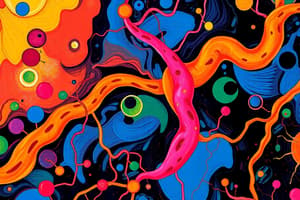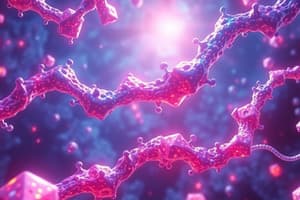Podcast
Questions and Answers
What is the net ATP consumption for each iteration of the Cori cycle?
What is the net ATP consumption for each iteration of the Cori cycle?
- 8 ATP
- 2 ATP
- 6 ATP
- 4 ATP (correct)
During periods of intense muscular activity, how is lactate managed in the body?
During periods of intense muscular activity, how is lactate managed in the body?
- Transported to the lungs for exhalation
- Converted directly to ATP in the muscles
- Converted to glucose in the liver via gluconeogenesis (correct)
- Stored as fat in the adipose tissue
What is the primary function of the Z scheme in the light reactions of photosynthesis?
What is the primary function of the Z scheme in the light reactions of photosynthesis?
- To reduce ATP to ADP
- To produce sugars from CO₂
- To generate a proton gradient (correct)
- To oxidize glucose into carbon dioxide
What role does cyclic electron flow play in photosynthesis?
What role does cyclic electron flow play in photosynthesis?
In which part of photosynthesis does CO₂ get fixed to form sugars?
In which part of photosynthesis does CO₂ get fixed to form sugars?
What is required for glycogen synthase to initiate the synthesis of glycogen?
What is required for glycogen synthase to initiate the synthesis of glycogen?
Which hormone primarily stimulates glycogenesis while inhibiting glycogenolysis?
Which hormone primarily stimulates glycogenesis while inhibiting glycogenolysis?
What is the primary site for gluconeogenesis in the human body?
What is the primary site for gluconeogenesis in the human body?
What is a major reason that glycolysis and gluconeogenesis do not function as a futile cycle?
What is a major reason that glycolysis and gluconeogenesis do not function as a futile cycle?
Which of the following is NOT a precursor for gluconeogenesis?
Which of the following is NOT a precursor for gluconeogenesis?
Which step in gluconeogenesis occurs in the mitochondrial matrix?
Which step in gluconeogenesis occurs in the mitochondrial matrix?
How is glycogenolysis affected by the blood glucose level?
How is glycogenolysis affected by the blood glucose level?
What is the energy cost of bypassing glycolysis during gluconeogenesis?
What is the energy cost of bypassing glycolysis during gluconeogenesis?
Which enzyme is primarily responsible for catalyzing the formation of glucose-1-P during glycogenolysis?
Which enzyme is primarily responsible for catalyzing the formation of glucose-1-P during glycogenolysis?
What is the key role of the debranching enzyme in glycogen metabolism?
What is the key role of the debranching enzyme in glycogen metabolism?
Which vitamin-derived cofactor is essential for the activity of glycogen phosphorylase?
Which vitamin-derived cofactor is essential for the activity of glycogen phosphorylase?
What thermodynamic property characterizes the reaction of glycogenolysis?
What thermodynamic property characterizes the reaction of glycogenolysis?
During glycogenesis, what is the first step in converting glucose to UDP-glucose?
During glycogenesis, what is the first step in converting glucose to UDP-glucose?
Which pathway generates glucose from non-carbohydrate precursors?
Which pathway generates glucose from non-carbohydrate precursors?
What is the fate of glucose-1-P once it is generated during glycogen breakdown?
What is the fate of glucose-1-P once it is generated during glycogen breakdown?
What role does UTP play in the formation of UDP-glucose during glycogenesis?
What role does UTP play in the formation of UDP-glucose during glycogenesis?
Flashcards
Cori Cycle
Cori Cycle
A metabolic pathway that removes lactate from muscles and converts it back to glucose in the liver, then returns glucose to the muscles.
Photosynthesis
Photosynthesis
Plants use sunlight to convert CO2 into sugars.
Light Reactions
Light Reactions
The first stage of photosynthesis, where light energy is converted to chemical energy (ATP and NADPH).
Dark Reactions (Calvin Cycle)
Dark Reactions (Calvin Cycle)
Signup and view all the flashcards
Chloroplasts
Chloroplasts
Signup and view all the flashcards
Glycogenolysis
Glycogenolysis
Signup and view all the flashcards
Glycogen Phosphorylase
Glycogen Phosphorylase
Signup and view all the flashcards
Debranching enzyme
Debranching enzyme
Signup and view all the flashcards
Glucose-1-P
Glucose-1-P
Signup and view all the flashcards
UDP-glucose
UDP-glucose
Signup and view all the flashcards
Glycogen Synthase
Glycogen Synthase
Signup and view all the flashcards
Glycogenesis
Glycogenesis
Signup and view all the flashcards
Muscle Glycogen
Muscle Glycogen
Signup and view all the flashcards
Glycogen Synthase function
Glycogen Synthase function
Signup and view all the flashcards
Glycogen Synthase primer
Glycogen Synthase primer
Signup and view all the flashcards
Gluconeogenesis
Gluconeogenesis
Signup and view all the flashcards
Gluconeogenesis location
Gluconeogenesis location
Signup and view all the flashcards
Glycolysis vs. Gluconeogenesis,Futile cycle
Glycolysis vs. Gluconeogenesis,Futile cycle
Signup and view all the flashcards
Reciprocal Regulation of Glycogen
Reciprocal Regulation of Glycogen
Signup and view all the flashcards
Insulin's Role in Glycogen
Insulin's Role in Glycogen
Signup and view all the flashcards
Epinephrine/Glucagon role in Glycogen
Epinephrine/Glucagon role in Glycogen
Signup and view all the flashcards
Study Notes
Glycogen Metabolism
- Glycogen is a homopolymer of α-D-glucopyranose.
- Liver glycogen is broken down for distribution to other organs via the bloodstream and maintaining proper blood glucose levels.
- Muscle glycogen is used to produce energy.
Glycogen Breakdown (Glycogenolysis)
- Glycogen phosphorylase catalyzes phosphorolysis, cleaving bonds by substituting a phosphate group. This forms glucose-1-phosphate.
- Pyridoxal phosphate is an essential cofactor, derived from Vitamin B6.
- Debranching enzyme (oligo(α-1,6→α-1,4) glucantransferase) removes branches, cleaving α-1,6 glycosidic bonds.
- Phosphoglucomutase converts glucose-1-phosphate to glucose-6-phosphate.
Release of Glucose as Glucose-1-P
- Glucose released is already phosphorylated, preventing it from leaving the cell.
- It readily enters glycolysis after converting to glucose-6-phosphate by phosphoglucomutase.
Re-modeling of Glycogen
- Restructuring occurs near branch points to prepare for further degradation.
- The action of glycogen phosphorylase continues until only 4 residues are left from the branch point.
De-branching
- α-1,6-glycosidic bonds are cleaved by α-1,6-glucosidase.
- Released glucose from de-branching is converted to glucose-6-phosphate, entering glycolysis.
Glycogen Synthesis (Glycogenesis)
- Enzymes involved are UDP-glucose pyrophosphorylase, glycogen synthase, and branching enzyme.
- UDP-glucose is the activated form of glucose, serving as a glucose donor for glycogen synthesis.
Formation of Glucose-6-P
- Hexokinase converts glucose into glucose-6-phosphate using ATP.
Conversion of Glucose-6-P to Glucose-1-P
- Phosphoglucomutase converts glucose-6-phosphate into glucose-1-phosphate.
Formation of UDP-Glucose
- UDP-glucose pyrophosphorylase converts glucose-1-phosphate and UTP to UDP-glucose and PPi.
Addition of Glucose to Glycogen
- Glycogen synthase links glucose molecules to a growing glycogen chain.
- It requires a primer chain of at least 4 glucose molecules.
- Glycogenin synthesizes the initial primer.
Branching
- Branching enzyme creates branches by transferring segments of 7 glucosyl residues in length
- New branch point is at least 4 residues away from another.
Hormonal Regulation of Glycogen Metabolism
- Insulin promotes glycogen synthesis and inhibits glycogen breakdown.
- Epinephrine (muscle) and glucagon (liver) induce glycogen breakdown.
- Glycogenolysis and glycogenesis are reciprocally regulated. Normal blood glucose is 70-100 mg/100 mL.
Gluconeogenesis
- Synthesizes glucose from non-carbohydrate precursors (e.g., pyruvate, lactate, glycerol, amino acids).
- Enzymes differ in irreversible steps from glycolysis to avoid futile cycles.
- Primarily occurs in the liver and kidney.
Cori Cycle
- Occurs during intense muscular activity (hypoxia).
- Lactate travels from muscles to liver, where gluconeogenesis transforms it to glucose.
- Glucose returns to muscles for glycogenesis or glycolysis.
- Prevents lactic acidosis and muscle cramps
Photosynthesis
- Autotrophic organisms convert CO₂ into sugars using light energy.
- Process occurs in chloroplasts.
Light Reactions (Photosynthesis)
- Converts light energy into chemical energy (ATP and NADPH).
- Occurs in thylakoid membranes.
Dark Reactions (Photosynthesis)
- CO₂ is fixed and reduced to form sugars.
- Uses ATP and NADPH.
- Occurs in the stroma.
Studying That Suits You
Use AI to generate personalized quizzes and flashcards to suit your learning preferences.



